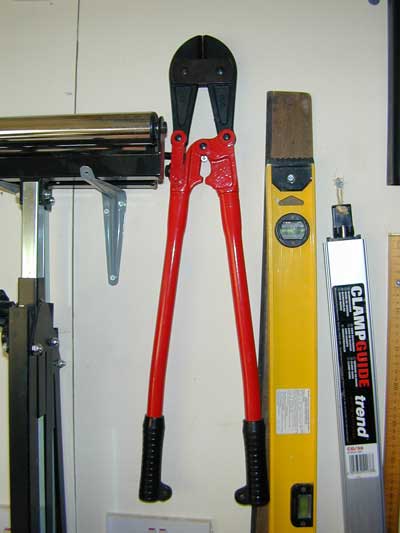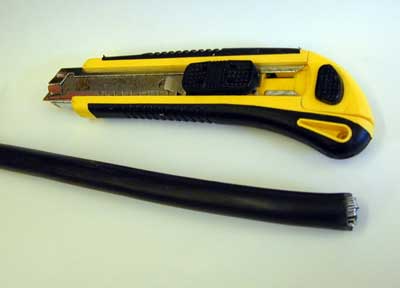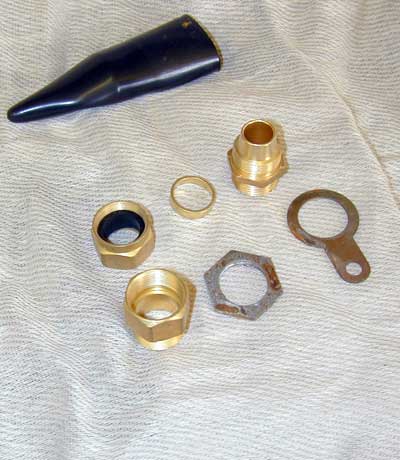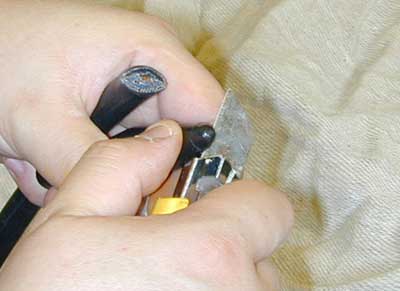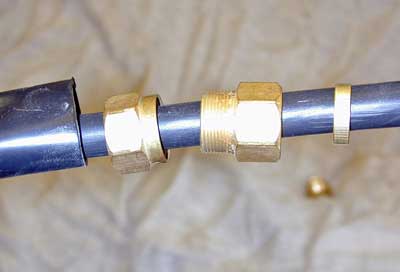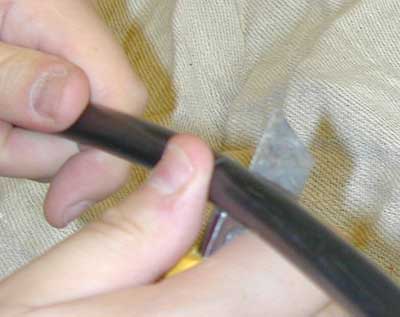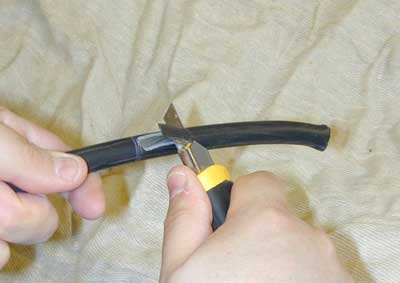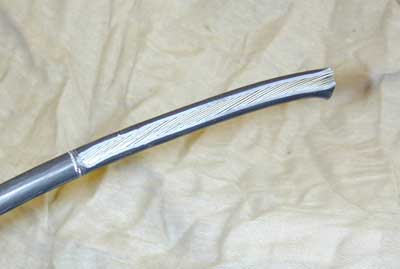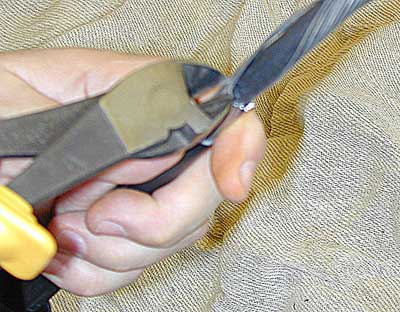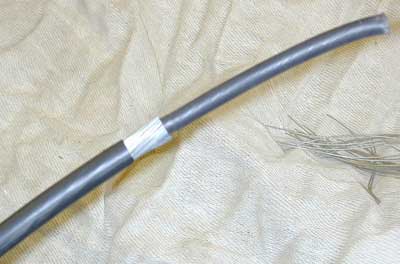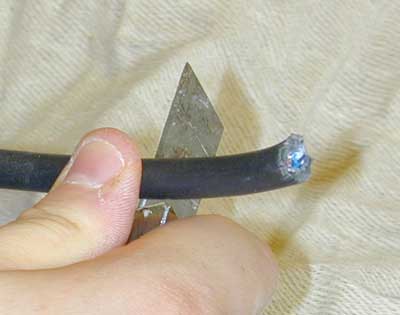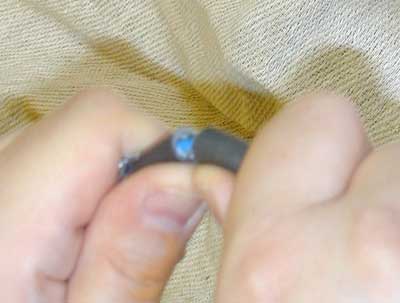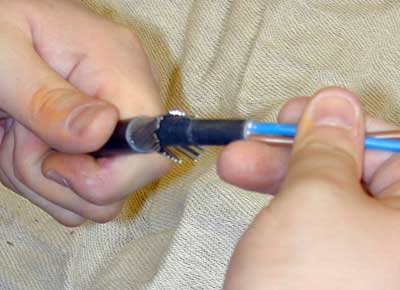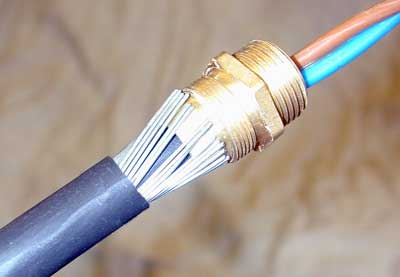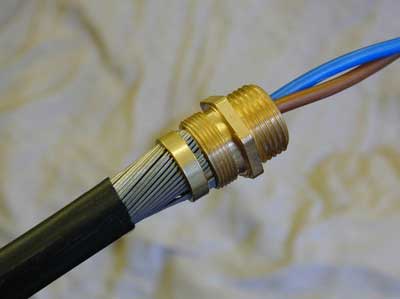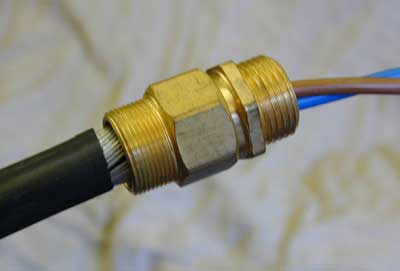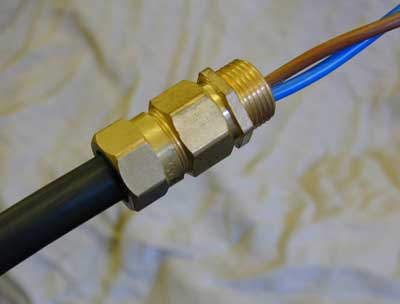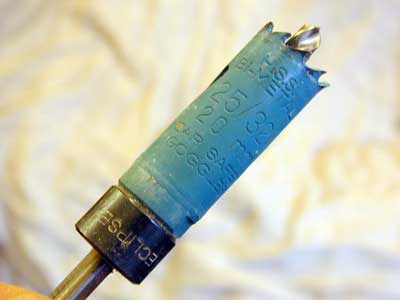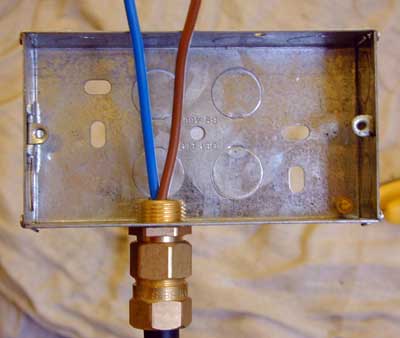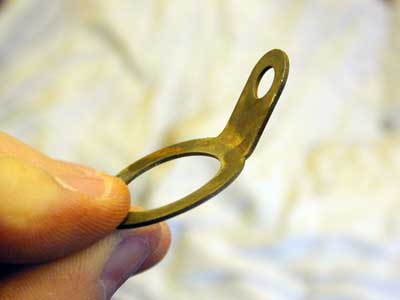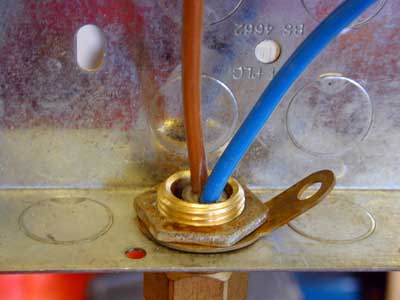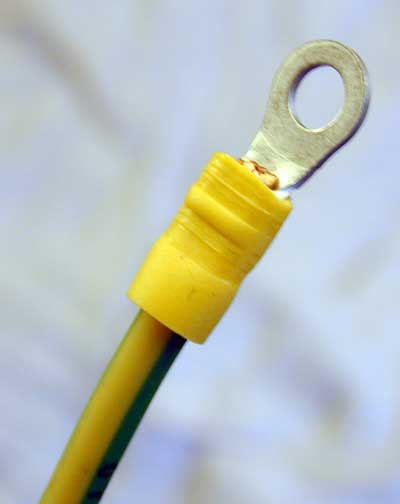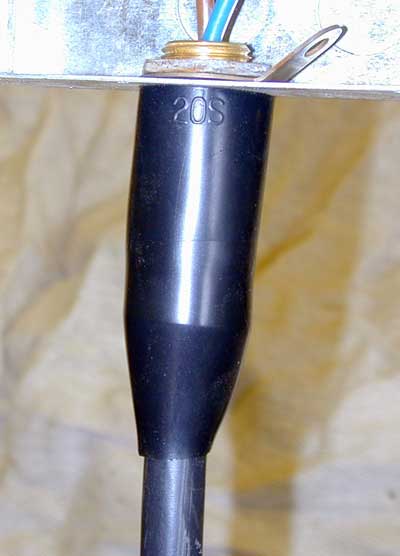Difference between revisions of "Terminating SWA"
(First draft) |
(Added section on using a hacksaw for cutting insulation and armour on larger cables.) |
||
| Line 58: | Line 58: | ||
=Step 3 - cutting the armour= | =Step 3 - cutting the armour= | ||
| − | The next step is to trim off most of the armour wire. You need to leave enough to fit over the cone section of the gland - about 40mm usually works for the smaller glands. Ideally you want the wires to splay at the same angle as the cone section to make assembly of the gland easier. Mark the cut position with a soft pencil, and then use a strong pair of cutters to snip off the wires a few at a time: | + | The next step is to trim off most of the armour wire. You need to leave enough to fit over the cone section of the gland - about 30 - 40mm usually works for the smaller glands. Ideally you want the wires to splay at the same angle as the cone section to make assembly of the gland easier. Mark the cut position with a soft pencil, and then use a strong pair of cutters to snip off the wires a few at a time: |
[[Image:SnipArmourWires.jpg]] | [[Image:SnipArmourWires.jpg]] | ||
Try to get the wires about the same length all round. Marking the cut position by ringing with a soft pencil or marking with a knife can help. | Try to get the wires about the same length all round. Marking the cut position by ringing with a soft pencil or marking with a knife can help. | ||
| + | |||
| + | With the heavier sized cables (say 10mm² and up), a better approach is to use a small hacksaw to cut a ring around the outer insulation at the place you want the armour wires to stop. Attempt to cut about half way through the armour as you go, and you should then be able to break of each of the wires with a quick wiggle. Once the armour is gone, go back to the knife and ring the outer insulation a little further up the cable to expose some of the armour ready for gland fitting. | ||
When done you should now have something looking like this: | When done you should now have something looking like this: | ||
Revision as of 22:30, 18 September 2007
| This page is awaiting peer review and comment.
Please do not rely on any information presented here yet. --John Rumm 21:50, 18 September 2007 (BST) |
Steel Wire Armoured (SWA) cable is a versatile and robust cable ideal for outdoor electrics. However it is difficult to work with due to its size and inflexibility, and also the requirement that all connections must be correctly terminated using appropriate termination glands. This article is a tutorial that shows how to correctly terminate Steel Wire Armoured (SWA) cable.
Cutting SWA
For the smaller and intermediate sizes of SWA, the quickest way to cut it to length is using a large pair of bolt croppers:
(for very large sizes of cable a hydraulic assisted cutter or saw may be a better option).
For the purposes of this example we will terminate some XLPE sheathed 4mm² two core SWA:
Gland Kits
There are a couple of different types of gland kit suitable for SWA cable; internal and external. Both types will ensure a very rigid fixing of the cable can be made to the box or unit where it connects. and that a good electrical connection can be made to the cable armour wires (used for protective earthing). In the case of the exterior gland kits, they also ensure the connection is waterproof.
This is a picture of the seven parts of the somewhat inappropriately named three part gland kit. This is the exterior waterproof style of gland. The interior version lacks the extra gland nut with the rubber insert that is used to seal the the gland against the cable.
Step 1 - Assemble the gland parts on the wire
This task is best done first, since there is nothing more irritating to complete a nice neat termination and then realised you forgot to fit one vital component of the gland on the wire. It also saves having to slide bits over the exposed armour or conductor wires.
First cut the nose of the plastic boot, such that the hole left will be a snug fit over the outer sheath of the cable. Use the cable as guide to the size required. The further up the conical section of the boot you cut, the bigger the hole left :
Now slide the boot onto the cable, followed by the back nut with the rubber seal (external glands only), next the main armour fixing nut, and finally the fixing ring:
Step 2 - Stripping the outer insulation
The easiest way to do this is with a sharp utility knife. Start by "ringing" the outer sheath by rotating the cable against the knife blade, applying pressure with your thumb to the other side of the cable. Start cutting a good few inches back from the free end so that you end up with enough cable to work with once the gland is fitted. You can be quite firm here since the armour will protect the cable from any damage (but blunt your knife a little!):
Next slice along the cable from the place you just cut round toward the free end:
Again the armour makes this easy with no risk of damaging the cable:
The last step is to pull off the outer sheath leaving the armour wires exposed.
Step 3 - cutting the armour
The next step is to trim off most of the armour wire. You need to leave enough to fit over the cone section of the gland - about 30 - 40mm usually works for the smaller glands. Ideally you want the wires to splay at the same angle as the cone section to make assembly of the gland easier. Mark the cut position with a soft pencil, and then use a strong pair of cutters to snip off the wires a few at a time:
Try to get the wires about the same length all round. Marking the cut position by ringing with a soft pencil or marking with a knife can help.
With the heavier sized cables (say 10mm² and up), a better approach is to use a small hacksaw to cut a ring around the outer insulation at the place you want the armour wires to stop. Attempt to cut about half way through the armour as you go, and you should then be able to break of each of the wires with a quick wiggle. Once the armour is gone, go back to the knife and ring the outer insulation a little further up the cable to expose some of the armour ready for gland fitting.
When done you should now have something looking like this:
Step 4 - Stripping the bedding or inner insulation
You don't have to carry out this job now, but it can make the wire end a bit more flexible to work with, so now is as good a time as any. There are a number of ways to do this, and which works best for you will partly depend on the tools you are using and the type of inner insulation your SWA has. The one used in this example has a fairly hard and inflexible insulation that is not easy to tear. So the simplest method is to ring it with a sharp knife as we did for the outer insulation:
Here we have to take care not to cut too deep or we will damage the individual conductor insulation. A deep score is usually enough. Next you can bend the inner at the scored point to break it. You should see a small gap open through which you can see the individual insulated wires:
Once you have broken the insulation all round you can usually slide it off the wires. Using a twisting motion often helps a little.
Step 5 - fitting the gland cone section
The cone section of the gland needs to slide between the inner insulation of the cable and under all the armour wires. To make this easy to do you need to splay the wires out a little first. One way to do this is the hold the cable in one hand, and the inner section of the cable in the other, and pull it to one side bending some of the amour wires out where they leave the outer sheath. Now move the inner round in an "orbiting" motion, so as to splay out all the wires:
Once the wires are splayed out, you can slide the cone section onto the end of the wire. Take car to ensure that none of the armour wires slip inside the cone, or they will damage the inner bedding insulation when you tighten up the gland nuts:
Next slide up the armour gripping ring:
And finally screw the armour locking back nut onto the cone section. This will force the grip ring up the cone section of the gland and trap the armour wires firmly in the gland. Use a pair of spanners to tighten the gland parts:
Step 6 - sealing the back of the gland
Now the armour is correctly clamped we can fit the cable sealing nut if we have one. This works like a compression fitting and sandwiches the internal rubber sealing sleeve against the outer insulation of the cable making it watertight:
Step 7 - Connecting to your box
Now the gland is fitted to the cable we can attach it to the actual box or panel that the cable is intended to connect to. For the smaller SWAs a 20mm knock out makes and ideal termination hole. Metal boxes often have pre-made holes ready to take SWA and conduit glands. Plastic ones will often need a knockout trimming out with a sharp knife first.
If you don't have an appropriate sized entry hole, (or you have the sort of hard plastic box that looks like it will shatter as soon as you look at it), then a small 20mm hole saw is ideal for making a suitable hole:
For this example we will terminate the gland on a standard metal box:
To make an effective earth connection to the armour there are a couple of ways of doing it. The standard way to do it is using the supplied earth tag and lock nut. Start by bending the tag a bit:
This will make soldering the earth wire to the tag simpler. You may find it better to solder your earth wire to the tag before you fit it. On plastic boxes this will save you melting the plastic, and on metal ones it stops the extra metal conducting all the heat away and making it hard to solder.
The tag is new clamped between the box wall and the lock nut:
If you don't want to solder to the tag, then you can crimp a ring terminal to the end of your earth wire:
and bolt this to the tag.
A nicer solution however is to dispense with the tag and log nut altogether, and use one of the proprietary fixing nuts like this that act as both lock nut, and also allow eye terminals to be screwed or bolted directly onto the nut.
The final job is to slide the plastic boot into place, making a nice neat job:
Job Done! You can now get on and do the wiring... and the other end of the cable!
Finally, unless you do lots of work with SWA, don't be surprised if fitting a gland properly takes 15 mins or more.
See Also
- Wiki Contents
- Wiki Subject Categories
- Cables
- Taking electricity outside
- Wiring colour codes
- Cable Resistances
